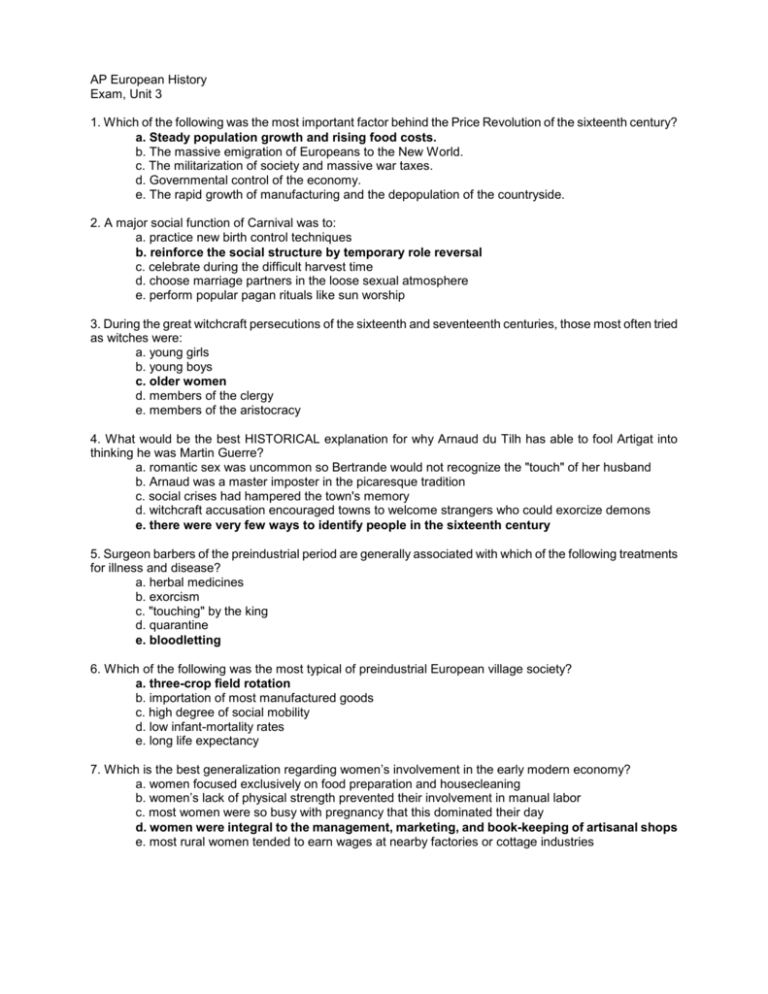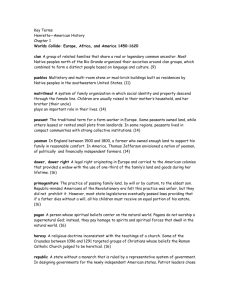
AP European History
Exam, Unit 3
1. Which of the following was the most important factor behind the Price Revolution of the sixteenth century?
a. Steady population growth and rising food costs.
b. The massive emigration of Europeans to the New World.
c. The militarization of society and massive war taxes.
d. Governmental control of the economy.
e. The rapid growth of manufacturing and the depopulation of the countryside.
2. A major social function of Carnival was to:
a. practice new birth control techniques
b. reinforce the social structure by temporary role reversal
c. celebrate during the difficult harvest time
d. choose marriage partners in the loose sexual atmosphere
e. perform popular pagan rituals like sun worship
3. During the great witchcraft persecutions of the sixteenth and seventeenth centuries, those most often tried
as witches were:
a. young girls
b. young boys
c. older women
d. members of the clergy
e. members of the aristocracy
4. What would be the best HISTORICAL explanation for why Arnaud du Tilh has able to fool Artigat into
thinking he was Martin Guerre?
a. romantic sex was uncommon so Bertrande would not recognize the "touch" of her husband
b. Arnaud was a master imposter in the picaresque tradition
c. social crises had hampered the town's memory
d. witchcraft accusation encouraged towns to welcome strangers who could exorcize demons
e. there were very few ways to identify people in the sixteenth century
5. Surgeon barbers of the preindustrial period are generally associated with which of the following treatments
for illness and disease?
a. herbal medicines
b. exorcism
c. "touching" by the king
d. quarantine
e. bloodletting
6. Which of the following was the most typical of preindustrial European village society?
a. three-crop field rotation
b. importation of most manufactured goods
c. high degree of social mobility
d. low infant-mortality rates
e. long life expectancy
7. Which is the best generalization regarding women’s involvement in the early modern economy?
a. women focused exclusively on food preparation and housecleaning
b. women’s lack of physical strength prevented their involvement in manual labor
c. most women were so busy with pregnancy that this dominated their day
d. women were integral to the management, marketing, and book-keeping of artisanal shops
e. most rural women tended to earn wages at nearby factories or cottage industries
8. A major economic difference between Eastern and Western Europe was:
a. a major decline in poverty in Western Europe in the eighteenth century
b. Eastern Europe's immunity from revolutionary stirrings
c. the continuing dependence of Eastern Europe on serfdom and large estates
d. the dominating role of the middle class in Eastern Europe
e. a lack of roads and canals in Western Europe
9. According to the graph above, which class in sixteenth-century Europe benefited most from the trends
shown?
a. landowners
b. landless laborers
c. household servants
d. merchants
e. small-scale artisans
10. Which of the following was LEAST likely to contribute to the witch scare of the period, 1500-1650?
a. positive attitudes toward women
b. widespread economic changes like the enclosure movement
c. a belief in supernatural scientific explanations
d. increased Bible reading and religious passion
e. the use of torture to extract confessions
11. Which of the following is the BEST explanation of the early modern practice of charivari?
a. it was designed to ward off evil demons
b. it was condemned as sacrilegious by the Catholic Church
c. it was a ritual of public humiliation to discourage unacceptable behavior
d. it was banned following the scandals over its misuse by government officials
e. it reinforced community solidarity with harmless fun
12. Which of the following is true of the German Peasants' Revolt of 1524-25?
a. The revolt led to the emancipation of the German serfs.
b. The revolt was organized by Martin Luther to break papal power in the German states.
c. The peasants were supported by the French army.
d. The revolt was the first in Europe in which equality was a major rallying point.
e. The revolt resulted from a combination of new religious ideas and economic hardship.
13. Early modern European couples delayed marriage until they were, on average, in their mid- to latetwenties because:
a. sexual maturation was delayed until then because of poor nutrition
b. they were concerned about scarcity of housing
c. they needed to acquire land or learn a trade before they could support a family
d. the customs and values of a society dominated by religion promoted sexual restraint
e. laws prohibited marriage without parental permission before the age of majority
Year
1300
European Population Data (in millions)
1500
1550
1600
3.5
2.8
3
France
15
16
18
Italy
8
6
11
13
12
12.5
8.3
6.3
7.6
5.2
7
9
11
9.5
16
85
100
80
100
Russia
All Europe
75
60
5
1700
England
Spain
4
1650
5.8
19
14. Which of the following can be concluded from the chart above?
a. Overall European population fluctuated between periods of growth and decline.
b. Spain's population decline was closely related to its persecution of religious minorities.
c. Italy experienced the greatest percentage population increase in the period.
d. Continuous war led to a massive decline in population from 1550-1700.
e. Renaissance improvements in medicine account for the sixteenth-century population increase.
15. A typical marriage in sixteenth-century Europe involved
a. a stress on romantic love
b. a male in his late 20s or early 30s and a women in her teens
c. a male in his mid-to-late 20s and a woman in her early-to-mid 20s
d. only economic matters, as romance was expressed through socially sanctioned prostitution
e. arranged marriages of teenagers
16. During the early modern period marriage among ordinary people:
a. involved total female subservience
b. was dominated by the wife
c. often ended in divorce
d. was rarely contracted until both parties were in their thirties
e. was an economic partnership
17. Apprentices were young people who were:
a. sold as slaves
b. sent to the colonies
c. supervised by journeymen
d. worked on farms
e. learned a craft
18. The persecution of witches came to an end in the seventeenth century because of all of the following
EXCEPT:
a. the scientific revolution
b. improved medical knowledge
c. decline of religious conflict
d. women were elevated in status
e. increase in social stability
19. Wives of merchants and artisans in early modern Europe:
a. were totally dependent on their husbands
b. were important partners in business
c. were expected only to cook and clean
d. could acquire guild status upon husband's death
e. rarely gave birth to more than two children
20. “All I can do is beg our virtuous ladies to raise their minds somewhat above their distaff and spindles and
try to prove to the world that if we were not made to command, still we should not be disdained as companions
in domestic and public matters by those who govern and command obedience.” In the excerpt above from a
letter written in 1555 by the French poet Louise Labe, the author does which of the following?
a. Rejects domestic roles for women.
b. Champions women’s intellectual abilities.
c. Condemns the French school system.
d. Encourages women to seek public office.
e. Asserts the social superiority of women.
21. Of the following, which setting provided unmarried women in preindustrial Europe with the greatest
opportunity to exercise their literary, artistic, and administrative talents?
a. government councils
b. convents
c. guilds
d. universities
e. banking houses
22. Which of the following best characterizes the Western European economy, as a whole, in the sixteenth
century?
a. widespread unemployment
b. declining trade and commerce
c. technological breakthroughs in production
d. unrestricted trade among nations
e. spiraling inflation
23. Which of the following best describes the enclosure movement?
a. A system of high tariffs erected by Philip II of Spain
b. A military maneuver developed by Henry VII of England
c. The fencing of common farmland in England for private use
d. A network of improved roads and bridges
e. The erection of a fortified line between France and Germany
24. What accounts for the tightening of serfdom in Eastern Europe at the same time peasants in Western
Europe were freed from the land?
a. weak monarchs in Eastern Europe were forced to grant concessions to a strong nobility
b. poor weather led to a decline in agricultural productivity in the East and debt peonage
c. nobles in Western Europe dismantled feudalism because of Renaissance ideals of equality
d. successful revolts West of the Elbe River liberated peasants from oppression
e. enlightened monarchs in the West proclaimed the freedom of peasants
25. The ______________ was a central institution of town life in the early modern period.
a. manor
b. court
c. neighborhood
d. guild
e. inn
26. Compared with their Western European counterparts, Eastern European peasants in the early modern
period:
a. enjoyed a greater degree of political freedom
b. enjoyed greater occupational opportunities
c. could compete for elective offices
d. owned less land and experienced less social mobility
e. were much more strongly affected by witchcraft persecutions
27. Illegitimate births and extramarital affairs were limited in early modern Europe (1500-1750) primarily
by:
a. the use of birth control
b. public rituals of humiliation
c. the rigid enforcement of national laws
d. religious principles
e. the relatively late age of marriage
28. Which of the following was NOT true of guilds in early modern society (1500-1700)?
a. they ensured minimum standards of quality for goods produced in a particular craft
b. they attempted to control the price and quantity of goods produced
c. many allowed membership for women under certain circumstances and in some
industries
d. they successfully organized those involved in rural manufacturing or cottage industry
e. they formed an important social and communal bond among their members
29. The map above shows which of the following about luxury shops in seventeenth-century Madrid?
a. Each street had an assortment of different types of shop.
b. Nobles living in the central square seldom bought jewelry.
c. Merchants selling similar goods grouped their shops next to each other.
d. The most profitable shops were located on the central square.
e. The great majority of the shops sold clothing.
30. Demographic changes in late sixteenth- and early seventeenth-century Europe contributed to:
a. state budget surpluses
b. price inflation and a decrease in real wages
c. greater equity in patterns of land ownership
d. market agriculture and a decline in commerce
e. higher population densities in eastern Europe than in western Europe
31. In seventeenth-century western Europe, marriage patterns showed a tendency toward:
a. intermarriage between peasant families and noble families
b. intermarriage between Christians and Jews
c. romantic love as the major factor in choosing a spouse
d. non-noble women marrying much younger men
e. relatively late first marriages by non-noble women










